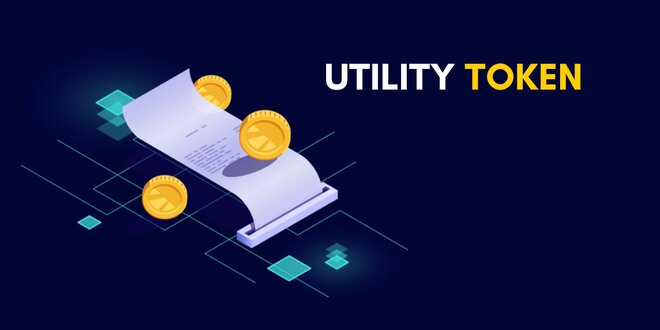While the term “cryptocurrency” is often used as an umbrella phrase to illustrate all digital assets, there are actually some specific types of cryptos. Most of them fall into two primary categories: tokens and coins. The most common types of tokens include security tokens and utility tokens. So, in today’s article, we are going to talk about crypto utility tokens.
Tokens are a different class of crypto. They are digital assets that are created on the blockchain of another cryptocurrency. Coins or currencies, on the other hand, have one operation and that is to transfer monetary value. BTC (Bitcoin) and LTC (Litecoin) are great examples of currencies.
What Are Crypto Utility Tokens?
A crypto utility token is a crypto token that caters to some use case within a specified ecosystem. These tokens enable users to enact some action on a certain network. This token is unique to its ecosystem. The BAT (Basic Attention Token) from Brave, for instance, can only be availed to tip content creators via the Brave browser or via other applications that offer integrated BAT wallets such as Twitter. There is no other use of BAT other than speculating its value. The same can be asserted for any crypto utility token. They are not mineable digital currencies. They are mainly pre-mined, being formed all at once and distributed in a system that is selected by the team associated with the project.
Utility Token vs Security Token
The primary difference between a utility token and also a security token is that security tokens offer rights of ownership to an entity. Anticipate them sort of like virtual, decentralized shares of stock. Security tokens are also categorized as securities by the financial regulators such as SEC (Securities and Exchange Commission), making them subject to all the similar rules as bonds, ETFs, stocks, and other securities. These are some of the security token examples.
While crypto utility tokens are not presently termed as securities, there has been some speculation that in the future, they could be. Even though these tokens are not intended to portray an investment the way that security tokens are, that is not what matters most to regulators. The SEC uses something known as the Howey Test to evaluate whether or not an investment is a security.
The criteria of this test are:
- A monetary investment
- People invest as they expect to earn money
- The investment is a “common enterprise,” implying investors will only make money depending on what the issuers of the investment do
- Profits are based on the operation of a third party
If the investment in question caters to the above boxes, the SEC thinks it secure. It is not hard to argue that they can apply to most tokens and digital currencies.
What Are Crypto Utility Tokens Used For?
A crypto utility token can serve just about any aims a developer wants it to. In general, these tokens offer access to a specific service or item with a blockchain ecosystem. In other words, you might require a certain utility token to be able to perform actions on a network of the Altcoin.
While digital currencies are a form of virtual money, crypto utility tokens might be better illustrated as a piece of software. They can be employed to transfer value, but that is generally not their main aim. To swap tokens on a DEX (decentralized exchange), or perform any number of DeFi (decentralized finance) activities, users may require a specific DEX token. Along with that, such a token could also be used to reward the users of the platform or to even payout interests to those who deposit funds that are then being lent out by the platform to the borrowers.
NFTs (Non-fungible tokens) serve as a form of the unique utility token, too. An NFT token is a one-of-a-kind digital piece of art, although NFTs can also be applied to things like music.
Crypto utility tokens that have been used in ICOs (Initial Coin Offerings) could even be used for fraudulent or malicious purposes. For instance, during the ICO craze of 2017-18, some latest blockchain projects provided crypto utility tokens to investors with promises of good returns. In reality, the projects were fraudulent and fake, and there was not even any new software application being constructed. Investors who plan to purchase ICO tokens like these often had no recourse and lost everything.
Examples of Utility Tokens
There are numerous crypto projects that have made use of a utility token. Here is a few famous crypto utility tokens list. Most of these tokens operate on the Ethereum network. So let us start with the utility tokens examples.
1. Basic Attention Token (BAT)
BAT token operates with the Brave browser, which is created to be private and secure. The BAT (Basic Attention Token) enables a new advertising revenue structure that does away with the requirement for constant tracking of users’ behavior. Brave users can receive BAT by opting in to see advertisements. BAT can then be employed to tip content creators on their websites or on Twitter. This is among the top utility tokens.
2. Chainlink (LINK)
Chainlink (LINK) is what is known as an “oracle.” Oracles input data from an outside source and upload that data to the blockchain. This can be helpful for smart contract apps that require real-time price data. With this, you will find many utility token use cases.
3. 0x (ZRX)
0x aims at creating a secure and fast crypto trading channel that integrates elements of both decentralized and centralized exchanges.
4. Binance Coin (BNB)
BNB (Binance Coin) falls under the section of “exchange tokens,” or a token that is native to a particular crypto exchange. In the case of Binance, users who hold this token on the platform enjoy a 25 percent discount on trading fees. Instead of the charges being taken in the form of fiat or the crypto being traded, fees are subtracted from the BNB balance of the trader instead.
5. Zilliqa (ZIL)
Zilliqa is a channel for formulating decentralized apps. The aim is to make these applications more secure and affordable for developers. ZIL tokens also have been used in facilitating digital advertising and gaming.
Challenges Faced By Crypto Utility Tokens
Apart from regulatory challenges, there are market and technological challenges related to the use of utility tokens.
One technical challenge includes transaction fees. As many crypto utility tokens are ERC-20 tokens operating atop the Ethereum blockchain, Ether gas fees can at times get very high. As more people compete for space in the next block, they bid up gas values, making it more expensive for all to make any transaction on the Ethereum network.
Like most Altcoins, these tokens can be used as vehicles for financial speculation. Based on the aim of the token, this could raise problems. If a certain dollar amount of tokens is needed for users to do something on a network, and then the dollar value of the token fluctuates to a great extent, users may struggle to predict how many tokens they require.
This is part of the reason why some utility tokens are stablecoins or cryptos that are created to maintain a 1:1 ratio with another asset because of a fiat currency like the U.S. dollar.
Conclusion
A utility token is a form of token that has a specific use scenario. Most of these tokens are formed on a prevailing blockchain like Ethereum — the cases that these tokens are used for are formulated using Ethereum smart contracts, and the token then operates atop the Ethereum blockchain.
Some other channels that developers might use for the same purposes include Tron (TRX or Tron token), Solana (SOL), or the Binance Smart Chain. In this article, we have also stated the most successful utility tokens in the crypto space.
- Bitcoin DCA: A Beginner’s Guide To Make Your Investments Easy - 02/04/2025
- 6 Most Funny Bitcoin Stories You Will Ever Know - 02/04/2025
- Easy Definition And Uses Of Crypto Regulatory Sandbox - 03/08/2024
 Crypto Venture News One stop Crypto Track Down
Crypto Venture News One stop Crypto Track Down 






